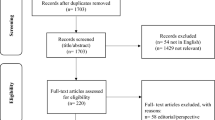Abstract
Computer-assisted test interpretation (CATI) is a set of developing technologies designed to support medical decision-making. This paper develops a taxonomy of computer-assisted test interpretation, giving specific consideration to the characteristics of the data that are to be interpreted, the nature of the interpretive task, the expected involvement of the health professional in the generation of the interpretation, the inference mechanism used for the interpretation, and the broader context of the interpretation. We go on to examine potential benefits and disadvantages of CATI systems in terms of accuracy, information management, interpretation time, patient management, medical communication, and expense. Finally, we examine electrocardiogram interpretation systems from the perspective of this taxonomy, and offer suggestions regarding areas of further inquiry into the effects of CATI on medical care.
Similar content being viewed by others
References
Federal Register. Department of Health and Human Services,Health Care Finan. Admin. 56(227): 1991.
Davis, M., Validation of computer software in process control applications.J. Parenter. Sci. Technol. 40:18–24, 1986.
Miller, R.A., and Masarie, F.J., The demise of the ‘Greek Oracle’ model for medical diagnostic systems.Methods Inf. Med. 29:1–2, 1990.
Zatti, M., Guidi, G., and Marcolini, F., Computer assisted laboratory diagnosis: a ten-year experience.Int. J. Biomed. Comput. 23:125–135, 1988.
Bessette, F., and Nguyen, L., Automated electrocardiogram analysis: the state of the art.Med. Inf. (Lond.). 14:43–51, 1989.
Davey, B.L., Fright, W.R., Carroll, G.J., and Jones, R.D., Expert system approach to detection of epileptiform activity in the EEG.Med. Biol. Eng. Comput. 27:365–370, 1989.
Boston, J.R., Automated interpretation of brainstem auditory evoked potentials: a prototype system.Ieee Trans. Biomed. Eng. 36:528–532, 1989.
Banks, G., Vries, J.K., and McLinden, S., Radiologic automated diagnosis (RAD).Comput. Methods Progr. Biomed. 25:157–167, 1987.
du Boulay, G.H., Teather, D., Morton, B.A., Wills, K.M., Innocent, P.R., and Plummer, D., Brains—a computer advisor system to aid in CT scan interpretation and cerebral disease diagnosis.Neuroradiology. 29:196–199, 1987.
Getty, D.J., Pickett, R.M., D'Orsi, C.J., and Swets, J.A., Enhanced interpretation of diagnostic images.Invest. Radiol. 23:240–252, 1988.
Lampeter, W.A., and Wandtke, J.C., Computerized search of chest radiographs for nodules.Invest. Radiol. 21:384–390, 1986.
O'Connor, M.L., and McKinney, T., The diagnosis of microcytic anemia by a rule-based expert system using VP-Expert.Arch. Pathol. Lab. Med. 113:985–988, 1989.
Barnett, G.C., Cimino, J.J., Hopp, J.A.,et al. DXplain: An evolving diagnostic decision support system.JAMA 258:67–74, 1982.
Jamieson, P.W., Computerized interpretation of electromyographic data.Electroencephalogr. Clin. Neurophysiol. 75:392–400, 1990.
Keel, B.A., Durfee, K.K., and Cho, S., A microcomputer data base system for maternal serum alpha fetoprotein screening programmed in BASIC.J. Perinat. Med. 17:221–229, 1989.
Wong, D.T., and Knaus, W.A., Predicting outcome in critical care: the current status of the APACHE prognostic scoring system.Can. J. Anaesth. 38(3):374–383, 1991.
Loughlin, J.F., Leung, F.Y., and Henderson, A.R., Classification of hyperlipoproteinaemias by computer interpretation.Ann. Clin. Biochem. 21:326–331, 1984.
Shortliffe, E.H., Buchanan, B.G., and Feigenbaum, E.A., Knowledge engineering for medical decision making: A review of computer-based clinical decision aids.Proc. IEEE. 67:1207–1224, 1979.
Reggia, J.A., and Tuhrim, S.,An Overview of Methods for Computer-Assisted Medical Decision Making. New York: Springer Verlag, 1985.
van Waeg, G., Groth, T., Niklasson, F., and de Verdier, C.H., Alloparinol kinetics in humans as a means to assess liver function: comparison of different models.Am. J. Physiol. 253:R352–360, 1987.
Hlatky, M.A., Using databases to evaluate therapy.Stat. Med. 10(4):647–652, 1991.
Hlatky, M.A., Califf, R.M., Harrell, F.E.,et al. Comparison of predictions based on observational data with the results of randomized controlled clinical trials of coronary bypass surgery.J. Am. Coll. Cardiol. 11(2):237–245, 1988.
Frauenhoffer, C.M., and Urban, C.H., Hepatitis profile interpretation by microcomputer.Am. J. Clin. Pathol. 84:366–370, 1985.
Macfarlane, P.W., A brief history of computer-assisted electrocardiography.Methods Inf. Med. 29:272–81, 1990.
Willems, J.L., Abreu-Lima, C., Arnaud, P.,et al. Effect of combining electrocardiographic interpretation results on diagnostic accuracy.Eur. Heart J. 9:1348–1355, 1988.
Thomson, A., Mitchell, S., and Harris, P., Computerized electrocardiographic interpretation: An analysis of clinical utility in 5110 electrocardiograms.Med. J. Aust. 151: 1989.
Grauer, K., Kravitz, L., Ariet, M., Curry, R.W., Nelson, W.P., and Marriott, H.J.L., Potential benefits of a computer ECG interpretation system for primary care physicians in a community hospital.J. Am. Bd. Fam. Pract. 2:17–24, 1989.
Kudenchuk, P.J., Ho, M.T., Weaver, W.D.,et al. Accuracy of computer-interpreted electrocardiography in selecting patients for thrombolytic therapy.J. Am. Coll. Cardiol. 17:1486–1491, 1991.
Willems, J.L., Abreu-Lima, C., van Bemmel, J.H.,et al. The diagnostic performance of computer programs for the interpretation of electrocardiograms.N. Engl. J. Med. 325:1767–1773, 1991.
Pipberger, H.V., McCaughan, D., Littmann, D.,et al. Clinical application of a second generation electrocardiographic computer program.Am. J. Cardiol. 35:597–608, 1975.
Alcover, I.A., Henning, R.J., Jackson, D.L., A computer-assisted monitoring system for arrhythmia detection in a medical intensive care unit.Crit. Care. Med. 12:888–891, 1984.
Feldman, R., Hillson, S.D., and Wingert, T., Measuring the components of physician work, under review.
Sridharan, M.R., and Flowers, N.C., Computerized electrocardiographic analysis.Mod. Conc. Cardiovasc. Dis. 53:37–41, 1984.
Rios, J., Sandquist, F., Ramseth, D., Stratbucker, R., Drazen, E., and Hanmer, J., Cost-Effectiveness of the electrocardiogram.Am. J. Cardiol. 41:175–183, 1978.
Drazen, E., Mann, N., Borun, R., Laks, M., Bersen, A., Survey of computer-assisted electrocardiography in the United States.J. Electrocardiol. Suppl:S98-S104, 1988.
Young, F.E., Validation of medical software: present policy of the Food and Drug Administration.Ann. Intern. Med. 106:628–629, 1987.
Norton, M.L., and Norton, E.V., Medical computers from the manufacturer's viewpoint.Comput. Methods Progr. Biomed. 25:229–236, 1987.
Brannigan, V., The regulation of medical computer software as a ‘device’ under the Food, Drug, and Cosmetic Act.Comput. Methods Progr. Biomed. 25:219–228, 1987.
Author information
Authors and Affiliations
Additional information
This work was supported entirely by federal funds from HCFA Cooperative Agreement 99-C-99169/5-03, at a total cost of $49,931. The statements contained in this paper are solely those of the authors and do not necessarily reflect the views or policies of the Health Care Financing Administration.
Rights and permissions
About this article
Cite this article
Hillson, S.D., Connelly, D.P. Computer-assisted test interpretation: Considerations in patient care. J Med Syst 16, 195–205 (1992). https://doi.org/10.1007/BF01000272
Issue Date:
DOI: https://doi.org/10.1007/BF01000272




